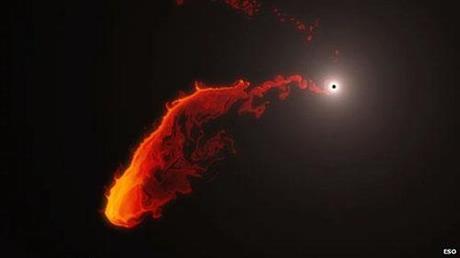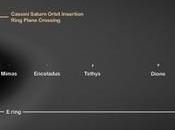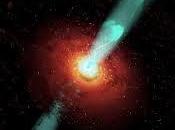
Credit: ESO/MPE/Marc Schartmann
Le ultime osservazioni del Keck Observatory alle Hawaii mostrano che la nube di gas chiamata "G2" è ancora sorprendentemente intatta, nonostante si trovi molto vicino al buco nero supermassiccio al centro della Via Lattea.
Gli astronomi dell'UCLA Galactic Center Group hanno riferito che le osservazioni del 19 e il 20 marzo 2014 mostravano ancora un oggetto sufficientemente "robusto" tanto da essere rilevato.
Questo potrebbe significare che G2 non è una semplice nube di gas ma nasconde una stella al suo interno.
L'oggetto G2 fu scoperto nel 2011 da Stefan Gillessen e il suo team del Max Planck Institute.
Appariva come un'enorme massa di gas al centro della nostra Galassia, non lontana ed in direzione di Sagittarius A* (Sgr A*), la sorgente di onde radio al centro della Via Lattea associata al mostruoso buco nero.
Data la situazione, gli astronomi avevano ipotizzato che G2 venisse attirato dal buco nero entro il 2013
A quanto pare, però, resiste oltre le previsioni e a metà marzo era ancora lì: non sta cadendo direttamente nel buco nero ma sta passando a circa 100 volte la distanza tra la Terra e il Sole da Sgr A*.
Secondo gli scienziati, però, sempre troppo vicino ed è comunque condannato alla distruzione.

Credit: ESO/MPE/Marc Schartmann
"G2 sta vivendo il suo massimo avvicinamento ancora intatto. In contrasto con le previsioni per una semplice nube di gas, l'ipotesi è quindi che ospiti una stella al suo interno. Le osservazioni del Keck LGSAO continueranno nei prossimi mesi per monitorare come questo oggetto insolito si evolve emergendo dal periasse", spiega il gruppo di astronomi nell'ultimo report.
We report new observations of Galactic Center sources G2 & SgrA* from the W. M. Keck Observatory. Both sources are of great interest and vary temporally; G2 is the putative gas cloud now passing through periapse in its orbit around the black hole at the center of the Milky Way Galaxy and SgrA* is the emission associated with the central black hole.
Our observations were obtained on 2014 March 19 & 20 (UT) with the Keck II laser guide star adaptive optics (LGSAO) system and the facility near-infrared camera (NIRC2) through the K'[2.1 µm] and L'[3.8 µm] broadband filters.
At this time, G2 was expected to have been at closest approach with a separation from SgrA* of only ~20 mas and, therefore, to be spatially unresolved from SgrA* in our L' observations, which have an angular resolution of ~90 mas. Nevertheless, the two can be disentangled spectrally.
In the L'-band, both Sgr A* and G2 contribute to the total flux; however, Sgr A*'s L' flux is estimated and removed based on (1) the K'-flux, where G2 does not contribute significantly, and (2) the well measured and constant K'-L' color of Sgr A*. Each night, roughly 20 interleaved measurements were made at each wavelength (exposure time of 28 and 30 sec at K' and L', respectively), with a duty cycle time of 134 sec for the two wavelengths. Our preliminary estimate of G2's 3.8 µm de-reddened flux density is 1.7 ± 0.2 mJy (or equivalently an observed magnitude of 14.1 ± 0.2 in the L'-band), which is consistent with measurements from earlier years (2002-2013).
During these observations, SgrA* was quite faint (3.8 µm de-reddened flux density of 1.5 ± 0.2 mJy, which is 1/30 of the maximum observed at near-infrared wavelengths), allowing G2's flux density to be robustly measured.
We conclude that G2, which is currently experiencing its closest approach, is still intact, in contrast to predictions for a simple gas cloud hypothesis and therefore most likely hosts a central star. Keck LGSAO observations of G2 will continue in the coming months to monitor how this unusual object evolves as it emerges from periapse passage.
Il fatto che G2 possa contenere una stella al suo interno, rende un evento già straordinario ancora più unico: gli astrofisici hanno la grande opportunità di vivere un'emozionante osservazione in "tempo reale" anche se oggi, G2 non esiste più da circa 25.000 anni, che è il tempo che la luce impiega a viaggiare fino a noi dal centro della Via Lattea.
Stay tunned per i prossimi aggiornamenti!



